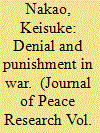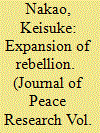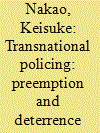|
|
|
Sort Order |
|
|
|
Items / Page
|
|
|
|
|
|
|
| Srl | Item |
| 1 |
ID:
184198


|
|
|
|
|
| Summary/Abstract |
Formal models of war termination have been developed along two major approaches: in one, war is interpreted as a series of battles, where nations exchange denials that aim to destroy enemy forces; in the other, war is illustrated as a process of bargaining with mutual punishments that inflict costs on opponents. By integrating these two approaches, I build a dynamic model of war, where two nations choose between military force and civilian value as the targets of their attacks in every battle. The war proceeds along one of the following three paths in equilibrium. First, either nation immediately gives in to the other’s threat of punishment such as nuclear strikes. Second, both the nations continue to conduct counterforce denial campaigns to weaken each other until either side is fully disarmed (i.e. all-out war). Third, after significant military imbalance is generated by the exchange of denials in an early battle, the winner of the battle switches to a countervalue punishment campaign, to which the loser responds by capitulation (i.e. limited war). My equilibrium analyses suggest that while denials largely determine a war’s outcome, punishments can influence its duration. Unlike existing models, mine illuminates the two-way causal relationship, where past battle outcomes can influence the choice of military strategy, whereas military strategies also shape how the war will further evolve.
|
|
|
|
|
|
|
|
|
|
|
|
|
|
|
|
| 2 |
ID:
141228


|
|
|
|
|
| Summary/Abstract |
Why do some rebellions expand gradually as rebel groups challenge in sequence, whereas other rebellions explode instantaneously as rebel groups challenge in unison? To address this question, we develop a dynamic and spatial model of rebellion that illustrates patterns of war fought between a hegemon (government) and its challengers (rebel groups). Our model incorporates three features into the standard coordination game: (a) potential rebel groups (players) are uncertain about the government’s strength; (b) battle outcomes are unpredictable; (c) these groups can be heterogeneous in terms of resolve and strength. In contrast to what existing theories commonly presume, our theory suggests that the sequence and timing of challenges are determined endogenously, depending on rebel groups’ resolve and strength. Through equilibrium analyses, we demonstrate that while simultaneous challenges are likely when rebel groups are relatively homogeneous, sequential challenges may emerge when one group is outstanding in terms of resolve and strength. Once this group rebels, other groups are inclined to ‘bandwagon’ as battles evolve, because the government is gradually revealed to be weak and because accumulated challenges shift the balance of power away from the government. Our theory also addresses why rebellious movements often spread across the periphery and can eventually reach the heartland as if a siege tightens. With an eye to historical incidents, we delineate four patterns of rebellion: (i) snowballing rebellion, which gradually escalates as more challengers are drawn in (Napoleonic Wars); (ii) catalytic rebellion, in which an instigator provokes a galvanizing event to inspire others to challenge the government (Boshin War); (iii) partially coordinated rebellion, which is initiated by a subset of ex post rebel groups (American Civil War, Yugoslav Wars); (iv) fully coordinated rebellion, in which all the rebel groups challenge collectively (American Revolution, Glorious Revolution).
|
|
|
|
|
|
|
|
|
|
|
|
|
|
|
|
| 3 |
ID:
165352


|
|
|
|
|
| Summary/Abstract |
Why does a state directly police certain kinds of transnational perpetrators by itself while indirectly policing other kinds through their host government? To address this question, we develop a formal model, where Defender chooses either to police Perpetrators or to make Proxy do so. According to our theory, the delegation of policing can enhance its effectiveness in light of Proxy’s three advantages: (a) Proxy can convince Perpetrators of punishments more credibly than Defender (communicative advantage); (b) Proxy is more likely to identify Perpetrators and detect what they hold dear (informational advantage); (c) Proxy can cripple and punish Perpetrators more effectively (offensive advantage). On the other hand, the delegation may cause inefficiency if Defender has limited information about Proxy’s choice or cost of policing. Depending on the relative size between these advantages and disadvantages, one of the following four forms of policing may emerge: (i) Defender polices Perpetrators on her own (e.g. Somali counter-piracy operations); (ii) Defender induces Proxy to police Perpetrators (U.S. War on Drugs in Colombia and Mexico); (iii) Defender and Proxy together police Perpetrators (Operation Inherent Resolve); (iv) two or more Defender-Proxy states police Perpetrators in each’s own domain (Interpol, Budapest Convention).
|
|
|
|
|
|
|
|
|
|
|
|
|
|
|
|
|
|
|
|
|